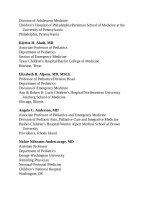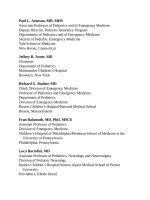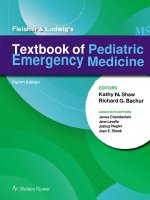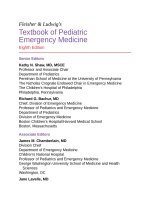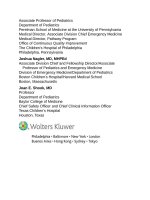Pediatric emergency medicine trisk 802
Bạn đang xem bản rút gọn của tài liệu. Xem và tải ngay bản đầy đủ của tài liệu tại đây (142.99 KB, 4 trang )
Drucker NA, McDuffie L, Groh E, et al. Physical examination is the best
predictor of the need for abdominal surgery in children following motor
vehicle collision. J Emerg Med 2018;54:1–7.
Lap Belt Complex
Borgialli DA, Ellison AM, Ehrlich P, et al. Association between the seat belt sign
and intra-abdominal injuries in children with blunt torso trauma in motor
vehicle collisions. Acad Emerg Med 2014;21:1240–1248.
Le TV, Baaj AA, Deukmedjian A, et al. Chance fractures in the pediatric
population. J Neurosurg Pediatr 2011;8:189–197.
Moremen JR, Nakayama DK, Ashley DW, et al. Traumatic disruption of the
abdominal wall: lap-belt injuries in children. J Pediatr Surg 2013;48:e21–e24.
Paris C, Brindamour M, Ouimet A, et al. Predictive indicators for bowel injury in
pediatric patients who present with a positive seat belt sign after motor vehicle
collision. J Pediatr Surg 2010;45:921–924.
Szadkowski MA, Bolte RG. Seatbelt syndrome in children. Pediatr Emer Care
2017;33:120–127.
Child Abuse
Maguire SA, Upadhyaya M, Evans A, et al. A systematic review of abusive
visceral injuries in childhood—their range and recognition. Child Abuse Negl
2013;37:430–445.
U.S. Department of Health and Human Services, Children’s Bureau
(Administration on Children, Youth and Families, Administration for Children
and
Families).
Child
maltreatment.
2018.
/>Diagnostic Laboratory in Abdominal Trauma
Capraro AJ, Mooney DP, Waltzman ML. The use of routine laboratory studies as
screening tools in pediatric abdominal trauma. Pediatr Emerg Care
2006;22:480–484.
Karaduman D, Sarioglu-Buke A, Kilic I, et al. The role of elevated liver
transaminase levels in children with blunt abdominal trauma. Injury
2003;34:249–252.
Lindberg DM, Shapiro RA, Blood EA, et al. Utility of hepatic transaminases in
children with concern for abuse. Pediatrics 2013;131:268–275.
Computerized Tomography as a Diagnostic Tool for Abdominal Trauma
Braungart S, Beattie T, Midgley P, et al. Implications of a negative abdominal CT
in the management of pediatric blunt abdominal trauma. J Pediatr Surg
2017;52:293–298.
Chatoorgoon K, Brown RL, Garcia VF, et al. Role of computed tomography and
clinical findings in pediatric blunt intestinal injury: a multicenter study. Pediatr
Emerg Care 2012;8(12):1338–1342.
Ellison AM, Quayle KS, Bonsu B, et al. Use of oral contrast for abdominal
computed tomography in children with blunt torso trauma. Ann Emerg Med
2015;66:107–114.e4.
Kerrey BT, Rogers AJ, Lee LK, et al. A multicenter study of the risk of intraabdominal injury in children after normal abdominal computed tomography
scan results in the emergency department. Ann Emerg Med 2013;62:319–326.
Menaker J, Blumberg S, Wisner DH, et al. Use of the focused assessment with
sonography for trauma (FAST) examination and its impact on abdominal
computed tomography use in hemodynamically stable children with blunt torso
trauma. J Trauma Acute Care Surg 2014;77:427–432.
Ultrasonography as a Diagnostic Tool for Abdominal Trauma
Fox JC, Boysen M, Gharahbaghian L, et al. Test characteristics of focused
assessment of sonography for trauma for clinically significant abdominal free
fluid in pediatric blunt abdominal trauma. Acad Emerg Med 2011;18:477–482.
Holmes JF, Kelley KM, Wootton-Gorges SL, et al. Effect of abdominal
ultrasound on clinical care, outcomes, and resource use among children with
blunt torso trauma: a randomized clinical trial. JAMA 2017;317:2290–2296.
Kessler DO. Abdominal ultrasound for pediatric blunt trauma: FAST is not
always better. JAMA 2017;317:2283–2285.
Liang T, Roseman E, Gao M, et al. The utility of the focused assessment with
sonography in trauma examination in pediatric blunt abdominal trauma: a
systematic review and meta-analysis. Pediatr Emerg Care 2019 Mar 12. doi:
10.1097/PEC.0000000000001755. [Epub ahead of print]
Scaife ER, Rollins MD, Barnhart DC, et al. The role for focused abdominal
sonography for trauma (FAST) in pediatric trauma evaluation. J Ped Surg
2013;48:1377–1383.
Williams SR, Perera P, Gharahbaghian L. The FAST and E-FAST in 2013: trauma
ultrasonography: overview, practical techniques, controversies, and new
frontiers. Crit Care Clin 2014;30(1):119–150.
CHAPTER 104 ■ BURNS
ANGELA M. ELLISON, MARGARET EMILY SAMUELS-KALOW
GOALS OF EMERGENCY CARE
As with any acute situation, the goals of emergency care for the burned
patient include the protection of the airway, and maintenance of breathing
and circulation. For the burned patient in particular, this will include
attention to the potential for inhalational injury and airway edema,
consideration of burn location and need for escharotomy to allow effective
chest wall movement, and early careful fluid resuscitation of burn shock.
Beyond immediate resuscitative interventions, appropriate wound care can
significantly improve both mortality and functional outcomes. Concomitant
control of pain is also an important aspect of care for the burned patient,
both to prevent unnecessary discomfort and to facilitate required
procedures. Finally, burn management aims at decreasing the risk of
infection created by disruption of barrier function of the skin, and
promoting healing and optimal cosmetic outcomes.
KEY POINTS
Burns should be described by estimated depth (superficial, partial
thickness, or full thickness) and total-body surface area (TBSA)
involved.
Significant burns are often accompanied by other injuries
(including ocular, inhalational, or traumatic) that may require
emergent assessment and treatment.
Full-thickness burns will be insensate due to destruction of the
cutaneous nerves of the dermis.
Severe burn injury requires intravenous fluid resuscitation, often
calculated using the Parkland formula: IV fluid volume (mL) =
(weight in kg) × (% TBSA burned) × 4. Half of this volume is given
in the first 8 hours and the remaining half during the subsequent
16 hours, in addition to maintenance fluids.
RELATED CHAPTERS
Resuscitation and Stabilization
Airway: Chapter 8
Shock: Chapter 10
Signs and Symptoms
Pain: Dysphagia: Chapter 56
Respiratory Distress: Chapter 71
Stridor: Chapter 75
Wheezing: Chapter 84
Medical, Surgical, and Trauma Emergencies
Child Abuse/Assault: Chapter 87
Toxicologic Emergencies: Chapter 102
The Children’s Hospital of Philadelphia Clinical Pathway
ED Pathway for Evaluation/Treatment of the Child With a Burn
Injury
URL: />Authors: M. Lavoie, MD; B. Koza, RN; D. Perks, CRNP; E.
Szydlowski, MD; J. Lavelle, MD
Posted: February 2012, last revised April 2018
INITIAL ASSESSMENT AND RESUSCITATION
CLINICAL PEARLS AND PITFALLS




